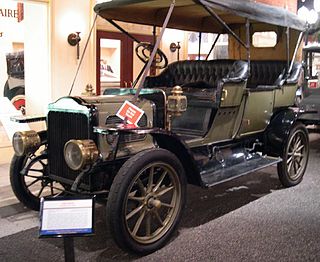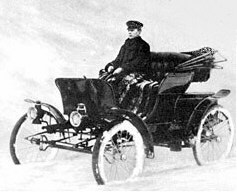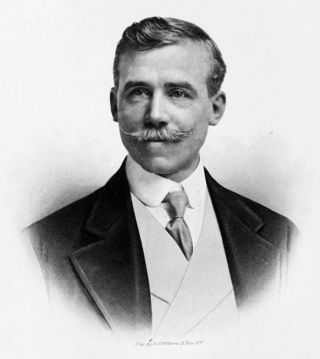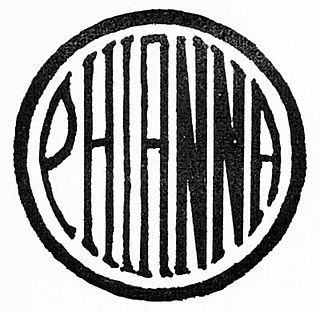
The Quinby was an American automobile manufactured in 1899 in Newark, New Jersey. [1] [2]

The Quinby was an American automobile manufactured in 1899 in Newark, New Jersey. [1] [2]
The Horseless Age magazine of March 1899 reported "'It is an unfailing sign of the times, when one of the oldest carriage-building firms in the country, noted for more than half a century for the excellence of their product, embarks in the manufacture of electric carriages.” [1]
J. M. Quinby & Company had been established in Newark in 1834. For a short time, Electric carriages were built to custom order only, though the firm provided a variety of adaptable styles. An electric "on the Leitner system", developed by Henry Moritz Leitner, Electrical Undertakings, Ltd., used two 2½ motors which were geared to the rear wheels. Many of the vehicles appear to have been exported, and the first Quinby Electric was tested in England, where it drove sixty miles without a charge averaging 12½ miles an hour. The battery accumulator system used regenerative braking. [1] [2]
Shortly after the turn of the century, when the Quinby electric car was discontinued, the firm turned to coach-building for the automotive industry. In 1902, Herbert T. Strong, one of Quinby's designers, patented a process for making composite aluminum over wood for automobile bodies. [2] This innovation helped launch their bodybuilding business. Quinby's annual Importers Salon exhibits consisted of a variety of open and closed body styles on various imported chassis - Benz, Daimler, Decauville, FIAT, Isotta-Fraschini, Lancia, Mercedes, Minerva, Panhard, Renault, and Rolls-Royce. American makes displayed at the New York Auto Show included Simplex, Jennis, Locomobile, Lozier, Matheson, Packard, Pennsylvania, Pierce (Great Arrow), Pierce-Arrow, Scott, Singer, Smith & Mabley and Wick. [2]
In March 1917 Quinby announced its retirement from business. [1]

McLaughlin Motor Car Company Limited was a Canadian manufacturer of automobiles headquartered in Oshawa, Ontario. Founded by Robert McLaughlin, it once was the largest carriage manufacturing factory in the British Empire.

The Detroit Electric was an electric car produced by the Anderson Electric Car Company in Detroit, Michigan. The company built 13,000 electric cars from 1907 to 1939.

Studebaker was an American wagon and automobile manufacturer based in South Bend, Indiana, with a building at 1600 Broadway, Times Square, Midtown Manhattan, New York City. Founded in 1852 and incorporated in 1868 as the Studebaker Brothers Manufacturing Company, the firm was originally a coachbuilder, manufacturing wagons, buggies, carriages and harnesses.

The Brass Era is an American term for the early period of automotive manufacturing, named for the prominent brass fittings used during this time for such features as lights and radiators. It is generally considered to encompass 1896 through 1915, a time when cars were often referred to as horseless carriages.

A Steam Car is a car (automobile) propelled by a steam engine. A steam engine is an external combustion engine (ECE), whereas the gasoline and diesel engines that eventually became standard are internal combustion engines (ICE). ECEs have a lower thermal efficiency, but carbon monoxide production is more readily regulated.

A coachbuilder or body-maker is a person or company who manufactures bodies for passenger-carrying vehicles. Coachwork is the body of an automobile, bus, horse-drawn carriage, or railway carriage. The word "coach" was derived from the Hungarian town of Kocs. A vehicle body constructed by a coachbuilder may be called a "coachbuilt body" or "custom body".

Fleetwood Metal Body was an automobile coachbuilder formed on April 1, 1909. The company name was derived from Fleetwood, Pennsylvania, home of the company at the start, and lived on for decades in the form of the Cadillac Fleetwood and various Fleetwood trim lines on Cadillac cars. As of 2022, the remaining original buildings of Fleetwood Metal Body are undergoing restoration and renovation into loft-style apartments.

In automotive use, a Stanhope is a car body style characterized by its single bench seat mounted at the center, folding cloth top, and a dashboard at the front. These vehicles were built from approximately 1900 to 1910. The design was derived from the Stanhope horse-drawn carriage and could be considered a specific type of runabout.

The Studebaker Electric was a car manufactured by the Studebaker Brothers Manufacturing Company of South Bend, Indiana, a forerunner of the Studebaker Corporation. The battery-powered cars were sold from 1902 to 1912.
Quinby may refer to:

Brewster & Company was an American custom carriage and motorcar coachbuilder. James Brewster established the company in 1810 which operated for approximately 130 years. Brewster got its start in New Haven, Connecticut, and quickly gained a reputation for producing the best carriages in the country. In 1827, he set his shop at 52 Broad Street in New York City.

Alexander Winton was a Scottish-American bicycle, automobile, and diesel engine designer and inventor, as well as a businessman and racecar driver. Winton founded the Winton Motor Carriage Company in 1897 in Cleveland, Ohio, making the city an important hub of early automotive manufacturing. His pioneering achievements in the automotive industry included taking one of the first long-distance journeys in America by car and developing one of the first commercial diesel engines. Winton left the automotive manufacturing business when he liquidated his car company in 1924 to focus on his powertrain engineering firm, Winton Gas Engine & Mfg. Co., which he had established twelve years earlier to focus on engine development. This business was sold to General Motors in 1930 and became the Cleveland Diesel Engine Division. Winton died in 1932 and is interred in Lake View Cemetery in Cleveland.

The automotive industry in Canada consists primarily of assembly plants of foreign automakers, most with headquarters in the United States or Japan, along with hundreds of manufacturers of automotive parts and systems, a sector represented by the APMA.

In the United States, the automotive industry began in the 1890s and, as a result of the size of the domestic market and the use of mass production, rapidly evolved into the largest in the world. The United States was the first country in the world to have a mass market for vehicle production and sales and is a pioneer of the automotive industry and mass market production process. During the 20th century, global competitors emerged, especially in the second half of the century primarily across European and Asian markets, such as Germany, France, Italy, Japan and South Korea. The U.S. is currently second among the largest manufacturers in the world by volume.

The Rauch & Lang Carriage Company was an American electric automobile manufactured in Cleveland, Ohio, from 1905 to 1920 and Chicopee Falls, Massachusetts, from 1920 to 1932.

Stearns Steam Carriage Company was a manufacturer of steam automobiles in Syracuse, New York, founded by Edward C. Stearns. Stearns built electric automobiles from 1899 to 1900 and steam cars from 1901 to 1903. The company was also known as the Stearns Automobile Company in 1903.

James Cunningham, Son and Company was an American business based in Rochester, New York, initially manufacturing horse-drawn coaches, that from 1908 onward developed and produced automobiles. The Cunningham company was a pioneer in automobile production, credited with being one of the world's first developers and manufacturers of automobiles and, in 1916, one of the first carmakers to produce an American V8 engine automobile. Its Cunningham automobile was a pioneering American production automobile.

Phianna was an American luxury automobile manufactured from 1916 to 1922, first in Newark, New Jersey and then Long Island City, New York.

Duncan & Fraser Limited was a vehicle manufacturing company founded in 1865 in Adelaide, South Australia that built horse-drawn carriages and horse trams, and subsequently bodies for trains, electric trams and motor cars, becoming one of the largest carriage building companies in Australia.